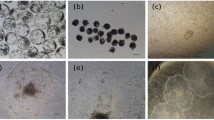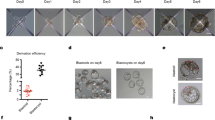Abstract
Currently worldwide attention has focused on the derivation of human embryonic stem cells (hESCs) for future therapeutic medicine. However, the majority of existing hESCs are directly or indirectly exposed to non-human materials during their derivation and/or propagation, which greatly restrict their therapeutic potential. Besides the efforts to improve culture systems, the derivation procedure, especially blastocyst manipulation, needs to be optimized. We adopted a non-contact laser-assisted hatching system in combination with sequential culture process to obtain hatched blastocysts as materials for hESC derivation, and derived a hESC line ZJUhES-1 of a Chinese population without exposure to any non-human materials during blastocyst manipulation. ZJUhES-1 satisfies the criteria of pluripotent hESCs: typically morphological characteristics; the expression of alkaline phosphatase, human telomerase reverse transcriptase and multiple hESC-specific markers including SSEA-3, SSEA-4, TRA-1-60, TRA-1-81, OCT-4, Nanog, Rex-1, Sox-2, UTF-1, Connexins 43 and 45, TERF-1 and TERF-2, Glut-1, BCRP-1/ABCG-2, GDF3, LIN28, FGF4, Thy-1, Cripto1/TDGF1, AC133 as well as SMAD1/2/3/5; extended proliferative capacity; maintenance of a stable male karyotype after long-term cultivation; and robust multiple-lineage developmental potentials both in vivo and in vitro. Moreover, ZJUhES-1 has distinct identity revealed from DNA fingerprinting. Our xeno-free blastocyst manipulation procedure may promote the progression toward clinical-grade hESC derivation.
Similar content being viewed by others
References
Thomson JA, Itskovitz-Eldor J, Shapiro SS et al. Embryonic stem cell lines derived from human blastocysts. Science 1998; 282: 1145–7.
Reubinoff BE, Pera MF, Fong CY, Trounson A, Bongso A. Embryonic stem cell lines from human blastocysts: somatic differentiation in vitro. Nat Biotechnol 2000; 18: 399–404.
Geens M, Mateizel I, Sermon K et al. Human embryonic stem cell lines derived from single blastomeres of two 4-cell stage embryos. Hum Reprod 2009; 24: 2709–17.
Zhang X, Stojkovic P, Przyborski S et al. Derivation of human embryonic stem cells from developing and arrested embryos. Stem Cells 2006; 24: 2669–76.
Strelchenko N, Verlinsky O, Kukharenko V, Verlinsky Y. Morula-derived human embryonic stem cells. Reprod Biomed Online 2004; 9: 623–9.
Stojkovic M, Lako M, Stojkovic P et al. Derivation of human embryonic stem cells from day-8 blastocysts recovered after three-step in vitro culture. Stem Cells 2004; 22: 790–7.
Heins N, Englund MC, Sjoblom C et al. Derivation, characterization, and differentiation of human embryonic stem cells. Stem Cells 2004; 22: 367–76.
Fang ZF, Jin F, Gai H et al. Human embryonic stem cell lines derived from the Chinese population. Cell Res 2005; 15: 394–400.
Liu W, Yin Y, Long X et al. Derivation and characterization of human embryonic stem cell lines from poor quality embryos. J Genet Genomics 2009; 36: 229–39.
Mannello F, Tonti GA. Concise review: no breakthroughs for human mesenchymal and embryonic stem cell culture: conditioned medium, feeder layer, or feeder-free; medium with fetal calf serum, human serum, or enriched plasma; serum-free, serum replacement non-conditioned medium, or ad hoc formula? All that glitters is not gold! Stem Cells 2007; 25: 1603–9.
Martin MJ, Muotri A, Gage F, Varki A. Human embryonic stem cells express an immunogenic nonhuman sialic acid. Nat Med 2005; 11: 228–32.
Sakamoto N, Tsuji K, Muul LM et al. Bovine apolipoprotein B-100 is a dominant immunogen in therapeutic cell populations cultured in fetal calf serum in mice and humans. Blood 2007; 110: 501–8.
Hisamatsu-Sakamoto M, Sakamoto N, Rosenberg AS. Embryonic stem cells cultured in serum-free medium acquire bovine apolipoprotein B-100 from feeder cell layers and serum replacement medium. Stem Cells 2008; 26: 72–8.
Richards M, Fong CY, Chan WK, Wong PC, Bongso A. Human feeders support prolonged undifferentiated growth of human inner cell masses and embryonic stem cells. Nat Biotechnol 2002; 20: 933–6.
Hovatta O, Mikkola M, Gertow K et al. A culture system using human foreskin fibroblasts as feeder cells allows production of human embryonic stem cells. Hum Reprod 2003; 18: 1404–9.
Stojkovic P, Lako M, Stewart R et al. An autogeneic feeder cell system that efficiently supports growth of undifferentiated human embryonic stem cells. Stem Cells 2005; 23: 306–14.
Wang Q, Fang ZF, Jin F, Lu Y, Gai H, Sheng HZ. Derivation and growing human embryonic stem cells on feeders derived from themselves. Stem Cells 2005; 23: 1221–7.
Xu C, Inokuma MS, Denham J et al. Feeder-free growth of undifferentiated human embryonic stem cells. Nat Biotechnol 2001; 19: 971–4.
Cheon SH, Kim SJ, Jo JY, Ryu WJ, Rhee K, Roh S 2nd. Defined feeder-free culture system of human embryonic stem cells. Biol Reprod 2006; 74: 611.
Lu J, Hou R, Booth CJ, Yang SH, Snyder M. Defined culture conditions of human embryonic stem cells. Proc Natl Acad Sci USA 2006; 103: 5688–93.
Yao S, Chen S, Clark J et al. Long-term self-renewal and directed differentiation of human embryonic stem cells in chemically defined conditions. Proc Natl Acad Sci USA 2006; 103: 6907–12.
Cowan CA, Klimanskaya I, McMahon J et al. Derivation of embryonic stem-cell lines from human blastocysts. N Engl J Med 2004; 350: 1353–6.
Antinori S, Selman HA, Caffa B, Panci C, Dani GL, Versaci C. Zona opening of human embryos using a non-contact UV laser for assisted hatching in patients with poor prognosis of pregnancy. Hum Reprod 1996; 11: 2488–92.
Solter D, Knowles BB. Immunosurgery of mouse blastocyst. Proc Natl Acad Sci USA 1975; 72: 5099–102.
Oh SK, Kim HS, Ahn HJ et al. Derivation and characterization of new human embryonic stem cell lines: SNUhES1, SNUhES2, and SNUhES3. Stem Cells 2005; 23: 211–19.
Ying QL, Stavridis M, Griffiths D, Li M, Smith A. Conversion of embryonic stem cells into neuroectodermal precursors in adherent monoculture. Nat Biotechnol 2003; 21: 183–6.
Gonzales DS, Jones JM, Pinyopummintr T et al. Trophectoderm projections: a potential means for locomotion, attachment and implantation of bovine, equine and human blastocysts. Hum Reprod 1996; 11: 2739–45.
Shay JW, Bacchetti S. A survey of telomerase activity in human cancer. Eur J Cancer 1997; 33: 787–91.
Amit M, Carpenter MK, Inokuma MS et al. Clonally derived human embryonic stem cell lines maintain pluripotency and proliferative potential for prolonged periods of culture. Dev Biol 2000; 227: 271–8.
Plaia TW, Josephson R, Liu Y et al. Characterization of a new NIH-registered variant human embryonic stem cell line, BG01V: a tool for human embryonic stem cell research. Stem Cells 2006; 24: 531–46.
James D, Levine AJ, Besser D, Hemmati-Brivanlou A. TGFbeta/activin/nodal signaling is necessary for the maintenance of pluripotency in human embryonic stem cells. Development 2005; 132: 1273–82.
Hoffman LM, Carpenter MK. Characterization and culture of human embryonic stem cells. Nat Biotechnol 2005; 23: 699–708.
Adewumi O, Aflatoonian B, Ahrlund-Richter L et al. Characterization of human embryonic stem cell lines by the International Stem Cell Initiative. Nat Biotechnol 2007; 25: 803–16.
Makrakis E, Angeli I, Agapitou K, Pappas K, Dafereras A, Pantos K. Laser versus mechanical assisted hatching: a prospective study of clinical outcomes. Fertil Steril 2006; 86: 1596–600.
Bider D, Livshits A, Yonish M, Yemini Z, Mashiach S, Dor J. Assisted hatching by zona drilling of human embryos in women of advanced age. Hum Reprod 1997; 12: 317–20.
Gabrielsen A, Bhatnager PR, Petersen K, Lindenberg S. Influence of zona pellucida thickness of human embryos on clinical pregnancy outcome following in vitro fertilization treatment. J Assist Reprod Genet 2000; 17: 323–8.
Ginis I, Luo Y, Miura T et al. Differences between human and mouse embryonic stem cells. Dev Biol 2004; 269: 360–80.
Carpenter MK, Rosler E, Rao MS. Characterization and differentiation of human embryonic stem cells. Cloning Stem Cells 2003; 5: 79–88.
Strom S, Inzunza J, Grinnemo KH et al. Mechanical isolation of the inner cell mass is effective in derivation of new human embryonic stem cell lines. Hum Reprod 2007; 22: 3051–8.
Ellerstrom C, Strehl R, Moya K et al. Derivation of a xeno-free human embryonic stem cell line. Stem Cells 2006; 24: 2170–6.
Cortes JL, Sanchez L, Catalina P et al. Whole-blastocyst culture followed by laser drilling technology enhances the efficiency of inner cell mass isolation and embryonic stem cell derivation from good- and poor-quality mouse embryos: new insights for derivation of human embryonic stem cell lines. Stem Cells Dev 2008; 17: 255–67.
Turetsky T, Aizenman E, Gil Y et al. Laser-assisted derivation of human embryonic stem cell lines from IVF embryos after preimplantation genetic diagnosis. Hum Reprod 2008; 23: 46–53.
Pruksananonda K, Rungsiwiwut R, Numchaisrika P, Ahnonkitpanich V, Virutamasen P. Development of human embryonic stem cell derivation. J Med Assoc Thai 2009; 92: 443–50.
Author information
Authors and Affiliations
Corresponding author
Additional information
These authors contributed equally to this work.
Rights and permissions
About this article
Cite this article
Wu, R., Xu, C., Jin, F. et al. Derivation, characterization and differentiation of a new human embryonic stem cell line from a Chinese hatched blastocyst assisted by a non-contact laser system. Hum Cell 23, 89–102 (2010). https://doi.org/10.1111/j.1749-0774.2010.00090.x
Received:
Accepted:
Issue Date:
DOI: https://doi.org/10.1111/j.1749-0774.2010.00090.x




